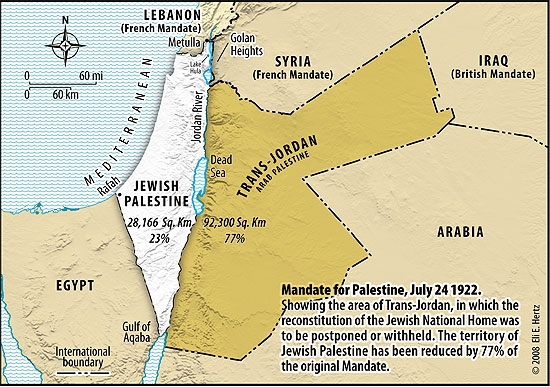
 The idea for a two state solution for Israel and Palestine is not new but many would be surprised to learn that this concept dates back to 1937 based on the British Peel Commission report. There was a proposed map that the commission recommended which was accepted by Jewish leaders but it was rejected by the Arab representatives.
The idea for a two state solution for Israel and Palestine is not new but many would be surprised to learn that this concept dates back to 1937 based on the British Peel Commission report. There was a proposed map that the commission recommended which was accepted by Jewish leaders but it was rejected by the Arab representatives.
It all started after WWI with the 1920 San Remo Conference held in Italy. The Conference set the framework to dissolve the Ottoman empire and thus, there was the Treaty of Sevres. It was replaced in 1923 by the Treaty of Lausanne, which voided previous Allied demands for Kurdish autonomy and Armenian independence but did otherwise recognize Turkey’s current boundaries.
Two mandates were created out of the San Remo Conference. The northern section of a newly partitioned land which included today’s Syria and Lebanon, was placed under the authority of France but the southern region came to be known as the British Mandate, which became Iraq, Transjordan, and a land called Palestine, based on the 1917 Balfour Declaration where the Jewish population could reside. The Balfour Declaration did favor the Jewish population but here’s the rub. It was not clearly written and it tends to ignore the Arabs as both Jewish and Arab residents dwelled in this same land and inevitably, after awhile there was significant fighting between the two camps.
Discontent in Palestine intensified after 1920, when the Conference of San Remo awarded the British government a mandate to control Palestine. With its formal approval by the League of Nations in 1922, this mandate incorporated the Balfour Declaration of 1917, which provided for both the establishment of a Jewish national home in Palestine and the preservation of the civil and religious (but not the political or national) rights of non-Jewish Palestinian communities. Palestinian Arabs, desiring political autonomy and resenting the continued Jewish immigration into Palestine, disapproved of the mandate, and by 1936 their dissatisfaction had grown into open rebellion. As a result, the Peel Commission was established to investigate the situation.
Two major plans were proposed to create two states (a land for the Jewish population) and (a region for the Arabs) in 1937 and 1947. Both plans were approved by Jewish leaders but were rejected by Arab representatives.
 The Peel Commission report of 1937, in full Royal Commission of Inquiry to Palestine, group headed by Lord Robert Peel, was appointed in 1936 by the British government to investigate the causes of unrest among Palestinian Arabs and Jews. The source of this and the following information with the map is from the Encyclopedia Britannica, classified under British History, and last updated on 9/3/ 2010.
The Peel Commission report of 1937, in full Royal Commission of Inquiry to Palestine, group headed by Lord Robert Peel, was appointed in 1936 by the British government to investigate the causes of unrest among Palestinian Arabs and Jews. The source of this and the following information with the map is from the Encyclopedia Britannica, classified under British History, and last updated on 9/3/ 2010.
“The Peel Commission published its report in July 1937. The report admitted that the mandate was unworkable because Jewish and Arab objectives in Palestine were incompatible, and it proposed that Palestine be partitioned into three zones: an Arab state, a Jewish state, and a neutral territory containing the holy places. Although the British government initially accepted these proposals, by 1938 it had recognized that such partitioning would be infeasible, and it rejected the commission’s report.”
As per Wikipedia, “partition was again proposed by the1947 UN Partition plan the division of Palestine. It proposed a three-way division, again with Jerusalem held separately, under international control. The partition plan was accepted by the Jewish leadership. However, the plan was rejected by the leadership of Arab nations and the Palestinians which opposed any partition of Palestine and any independent Jewish presence in the area. “
 As soon as the British Mandate ended, the 1948 Arab-Israeli War ensued which was instigated by neighboring Arab countries. The fighting came to an end with the 1949 Armistice Agreements. The war resulted in the fleeing or expulsion of up to 800,000 Arabs living in what was known as Jewish Palestine which became the State of Israel. The area known as the West Bank ended up under the rule of Transjordan from 1948-1967.
As soon as the British Mandate ended, the 1948 Arab-Israeli War ensued which was instigated by neighboring Arab countries. The fighting came to an end with the 1949 Armistice Agreements. The war resulted in the fleeing or expulsion of up to 800,000 Arabs living in what was known as Jewish Palestine which became the State of Israel. The area known as the West Bank ended up under the rule of Transjordan from 1948-1967.

The new frontiers for Israel, as set by the agreements, encompassed about 78% of mandatory Palestine as it existed after the independence of Transjordan (now Jordan) in 1946. The Arab populated areas not controlled by Israel prior to 1967 were the West Bank occupied by Jordan and the Gaza Strip occupied by Egypt.
The armistice agreements were supposed to be temporary measures until replaced by permanent peace treaties. However, no peace treaties were officially signed until decades later. As per Arab insistence, none of the borders based on the Armistice Agreements were to be permanent.